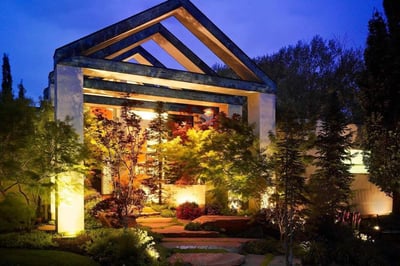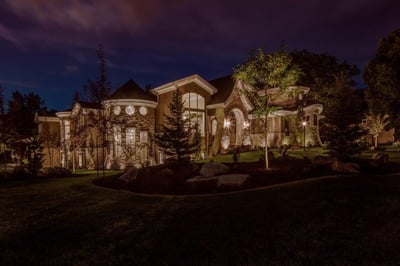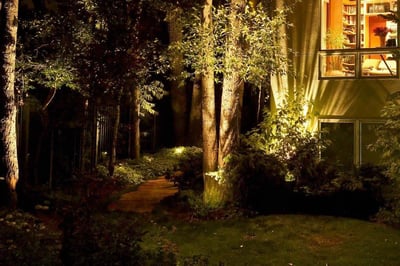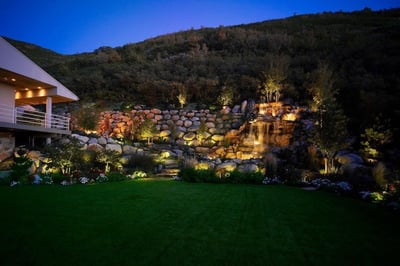Is LED Lighting Sustainable? A Review of Usage and Cost Savings

I used to get a lot of pushback from clients about LED lighting. They worried about the color — would it be too cold and stark? — and the upfront cost.
But not anymore.
Most people now know that LED lighting has come a long way since it first arrived on the market a few years ago. The color is as warm and inviting as the halogen outdoor lights they love.
But the best quality about outdoor LED lighting is how sustainable it is. The cost savings over time is phenomenal. The bulbs are recyclable. And the energy savings will make you feel great about your carbon footprint.
Let’s take a closer look at the sustainability of LED lighting.
First, The Numbers
Low-voltage LED outdoor lighting uses just 15 to 20 percent of the electricity we use with halogen or incandescent bulbs. This means far lower energy bills.
Opt for LED lighting, and you’ll pay about $5 a month on your electric bill. My customers with the largest, most extensive LED systems pay about $20 a month.
At my own house, I went from using 800 watts with my halogen system to 130 watts with my LED lights. That’s about the same energy consumption as leaving two incandescent lamps with 60-watt bulbs on for five hours a day.
And that’s all the output I need to do an entire landscape front to back, with LED lighting.
A Look At The Payback

While the upfront cost for an LED lighting system is higher than a halogen system, it doesn’t take long for it to pay for itself in energy savings.
A cost analysis comparing LED to halogen outdoor lighting shows that with a modest residential lighting installation, the cost savings shows up starting with the fifth year and increases each year after that.
By year 10, a homeowner will have saved $1,009.50 by switching to an LED system.
These figures are based on a landscape lighting system that includes 11 uplights, 5 downlights, 3 path lights and 7 deck lights, operating 6 hours per night for 365 nights.
To operate a system like this with halogen lights, it would cost $130.35 a year. To operate it with LED lights, the cost plummets to $31.80 per year.
And the savings goes beyond electricity costs.
Less Power Means Less Strain On Mother Earth
It would take 620 feet of wire to install the above system with halogen lights — to account for the halogen bulbs’ susceptibility to voltage drop. But to install it with an LED system? Just 150 feet of wire. (LEDs are built to withstand voltage drop.)
And the example halogen system would require a 500-watt transformer to handle the lighting load. But the LED system would require just a 250-watt transformer — and that’s allowing plenty of room for additional lights later on.
For a large landscape lighting installation, I used to need a 1,000-watt transformer to handle the output needed for halogen lights.
With LED, I only need a 150- to 300-watt transformer to carry hundreds of lights. Again, I need less than half the wire.
A smaller transformer and less wire translate into huge savings.
But Don’t Just Take Our Word For It
In 2012, about 49 million LEDs were installed in the U.S. — saving about $675 million in annual energy costs, the U.S. Department of Energy reports.
Switching entirely to LED lights over the next two decades could save the U.S. $250 billion in energy costs, reduce electricity consumption for lighting by nearly 50 percent and avoid 1,800 million metric tons of carbon emissions.
If every American replaced one conventional light bulb with an LED, the energy savings could light an estimated 2.5 million homes.
More Savings On Maintenance

There’s additional savings when you factor in maintenance for LED lighting — there isn’t much to do.
Landscape Lighting Pro of Utah recommends replacing halogen bulbs once a year. With LEDs, we replace them only when they fail. And don’t hold your breath for that, because many of today’s LED bulbs are rated to last 50,000 hours.
We sell our LED lighting systems with a lifetime warranty that covers fixtures and installation. That lifetime warranty doesn’t cover the bulbs, but those come with a five-year manufacturer’s warranty.
In addition, we offer a one-year “bumper to bumper” warranty that covers any trouble. Do you have a timer issue? A bulb fails? A light needs to be readjusted or re-aimed? It’s covered for the first year after installation of your LED outdoor lighting system.
The Sustainability Continues: LEDs Are Recyclable
Because LEDs are so efficient, you don’t have to worry about disposing of them very often.
But when those years pass and you finally need to replace them, there’s good news: they’re recyclable.
While landfills are stuffed with old burned out MR16 bulbs, LEDs shouldn’t go to the landfill. They don’t contain mercury, but they do contain nickel, some lead, and trace amounts of arsenic. When used properly, these lights are risk-free, but they have significant health hazards when they’re left in a landfill.
More than 95 percent of an LED bulb is recyclable. Just call your local waste management company to learn its policies for collecting and recycling. The recycling process will separate the lenses from the other elements, all of which will eventually be recycled and reused.
LEDs Aren’t Just Practical — They’re Beautiful

When LEDs first came on the market, they were limited in what they could accomplish. Halogen bulbs gave us better beam spread and color options, which meant more flexibility in our lighting designs.
But slowly LEDs started catching up. Now I think they’ve actually surpassed halogen in their design capability.
There are far more color options, more wattage options and better beam spreads.
LEDs now give us the right tools for the job.
It means for your linden tree, I can use just three 45-degree, 7-watt LED bulbs with a 3000 Kelvin temperature for beautiful light. With halogen bulbs, I needed three 50-watt bulbs to do the same job. From 50 watts down to 7? That’s a huge savings in wattage.
For your Japanese maple, I need just a single 1.5-watt bulb with 120-degree beam spread and a 2700 Kelvin temperature. Because of the wide beam spread now available in LED, I can cover the full canopy of that Japanese maple, edge to edge, for a nice soft effect. With hardly any wattage at all.
LEDs Are The Right Choice
Thanks to a longer lasting product and dramatically reduced energy consumption, utilizing low-voltage LED lighting in a Landscape Lighting Pro of Utah design will actually save you money in the end.
And you can feel good about your drastically reduced carbon footprint.
Give Us A Call
To learn more about outdoor LED lighting in your landscape, call (801) 440-7647 to schedule a free consultation, or fill out our simple contact form.
Landscape Lighting Pro of Utah serves customers throughout Utah’s residential areas, including Salt Lake City, Park City, Draper and Holladay. Our outdoor lighting portfolio includes projects from Salt Lake County and Utah County, to Davis County and Summit County — and beyond.
Salt Lake City (Midvale)
801-440-7647
St. George
435-932-6627
©2025 Landscape Lighting Pro
Privacy Policy
Cookie Policy